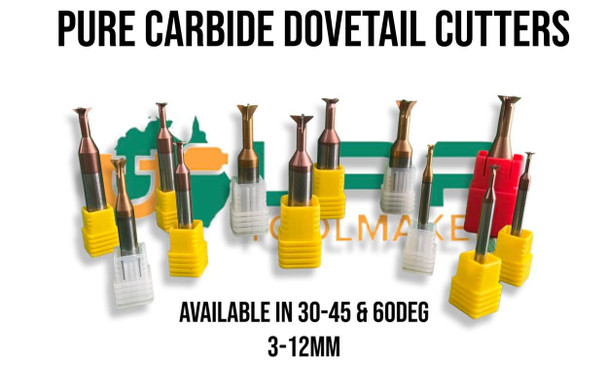Description
Pure Carbide Dovetail Cutters (4 Flute)
Size & Angle variations between 3mm & 12mm.
Available in 30, 45 or 60 Degree angles.
GROUND FROM PURE CARBIDE. RATED 55RC
Special product which has been manufactured to ANSI standards for our APRICA brand of tools. High quality & reliability.
SIZES WE STOCK
| OD (Outer Diameter) | Flute | Angle | Shank Diameter |
|---|---|---|---|
| 3mm | 4 | 45° | 4mm |
| 4mm | 4 | 45° | 4mm |
| 4mm | 4 | 60° | 4mm |
| 6mm | 4 | 30° | 6mm |
| 6mm | 4 | 45 | 6mm |
| 6mm | 4 | 60° | 6mm |
| 8mm | 4 | 30° | 10mm |
| 8mm | 4 | 45° | 10mm |
| 10mm | 4 | 45° | 10mm |
| 10mm | 4 | 60° | 10mm |
| 12mm | 4 | 30° | 12mm |
| 12mm | 4 | 45° | 12mm |
| 12mm | 4 | 60° | 12mm |
Carbide is generally considered to be a superior cutting tool material compared to high-speed steel (HSS) due to its hardness, wear resistance, and toughness.
Here are some reasons why pure carbide is often preferred over HSS for dovetail cutting:
Hardness: Carbide is much harder than HSS, which means it can maintain a sharp cutting edge for longer periods of time. This is especially important for dovetail cutting, where precision is crucial.
Wear resistance: Carbide is also more wear-resistant than HSS, meaning it can withstand more cutting without becoming dull. This allows for more consistent and accurate cutting over a longer period of time.
Toughness: While carbide is very hard and wear-resistant, it can also be brittle. However, advancements in carbide manufacturing have led to the creation of tougher carbide materials that are more resistant to chipping and breaking.
Heat resistance: Carbide is also better at handling high temperatures than HSS, which can become soft and lose its cutting edge under high heat conditions. This makes carbide an ideal choice for cutting hard and tough materials like stainless steel, titanium, and Inconel.
Cost-effectiveness: While carbide cutting tools may be more expensive than HSS, they tend to last longer and require less frequent replacements. This can lead to cost savings in the long run.
Overall, the hardness, wear resistance, toughness, heat resistance, and cost-effectiveness of pure carbide make it a popular choice for dovetail cutting and other precision machining applications.
Beginner's Guide To Using Dovetail Cutters:
Dovetail cutting is a type of machining process used to create a specific type of joint called a dovetail joint. This joint is commonly used in woodworking, but can also be used in metalworking and other industries.
Tools needed for dovetail cutting: To perform dovetail cutting, you will need a dovetail cutter and a machine capable of performing the cutting process. The dovetail cutter is a specialized cutting tool designed to create the dovetail shape.
-
Set up the machine and the workpiece: Ensure that the machine is properly set up and that the workpiece is securely fastened in place.
-
Select the appropriate dovetail cutter: Choose a dovetail cutter that is the right size and shape for the joint you want to create.
-
Determine the cutting depth: Decide on the depth of the cut you want to make and adjust the machine settings accordingly.
-
Perform the cutting process: Use the machine to carefully cut the dovetail shape into the workpiece. Make sure to take your time and proceed slowly and carefully to ensure accuracy.
-
Check the fit: Once the cutting is complete, check the fit of the joint to ensure it is snug and secure.
Tips for success:
-
Use the appropriate cutter for the job: Choose a cutter that is the right size and shape for the joint you want to create.
-
Take your time: Dovetail cutting requires patience and precision, so take your time and proceed carefully.
-
Use appropriate safety measures: Always wear appropriate protective gear, such as eye and ear protection, when operating machinery.
-
Practice: Like any skill, dovetail cutting takes practice to master. Keep practicing and refining your technique to achieve the best results.
As you gain more experience, you can experiment with different techniques and tools to achieve even more precise and intricate joints.




































